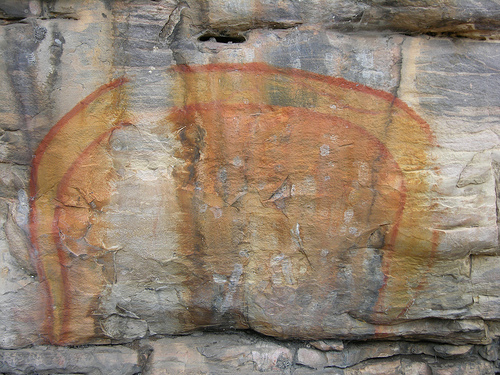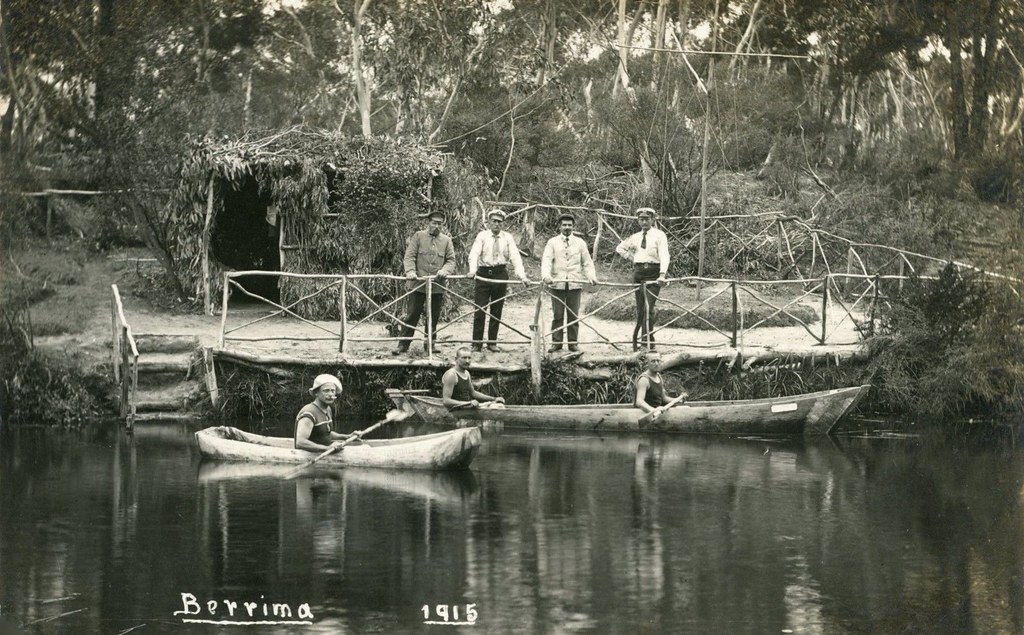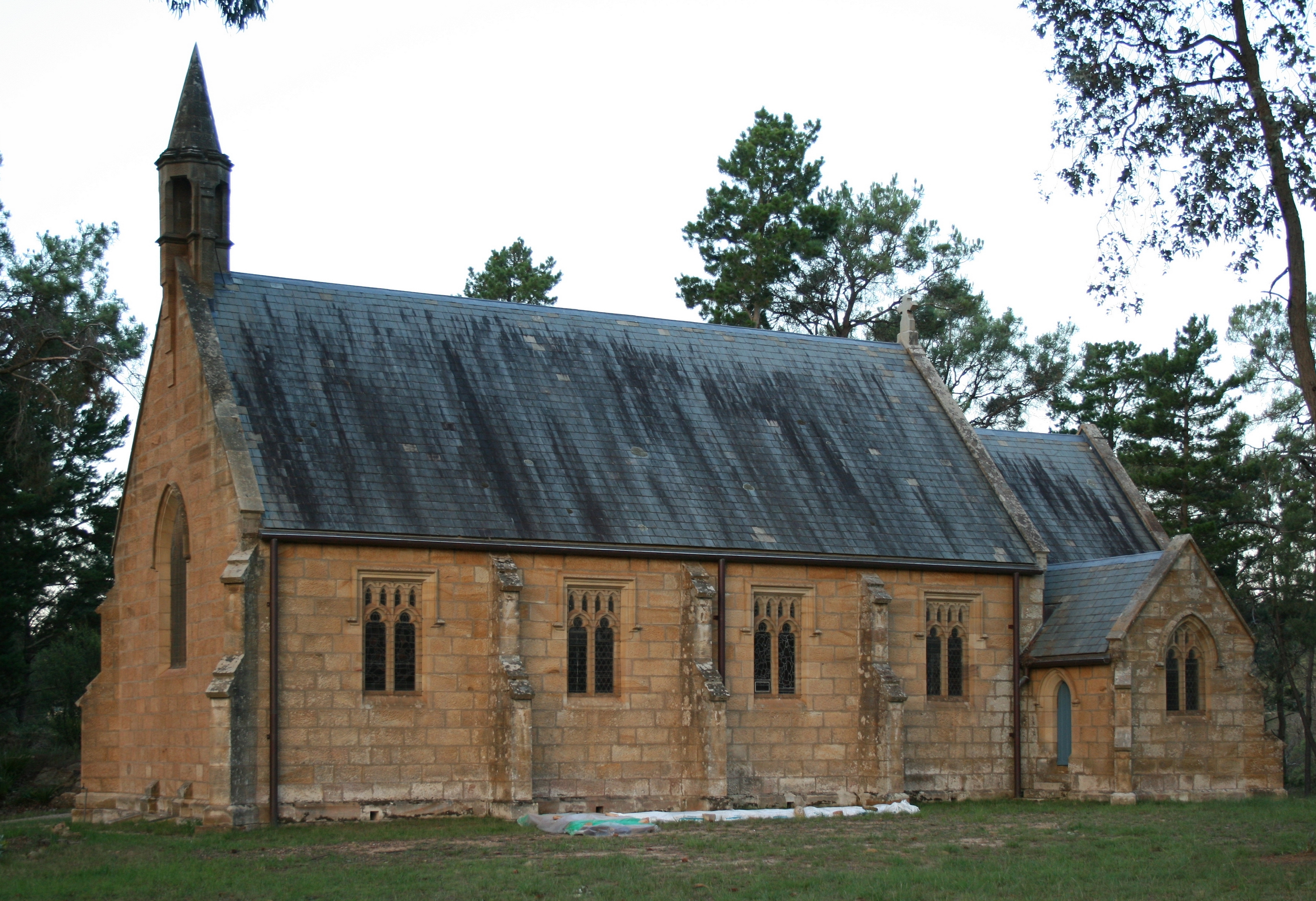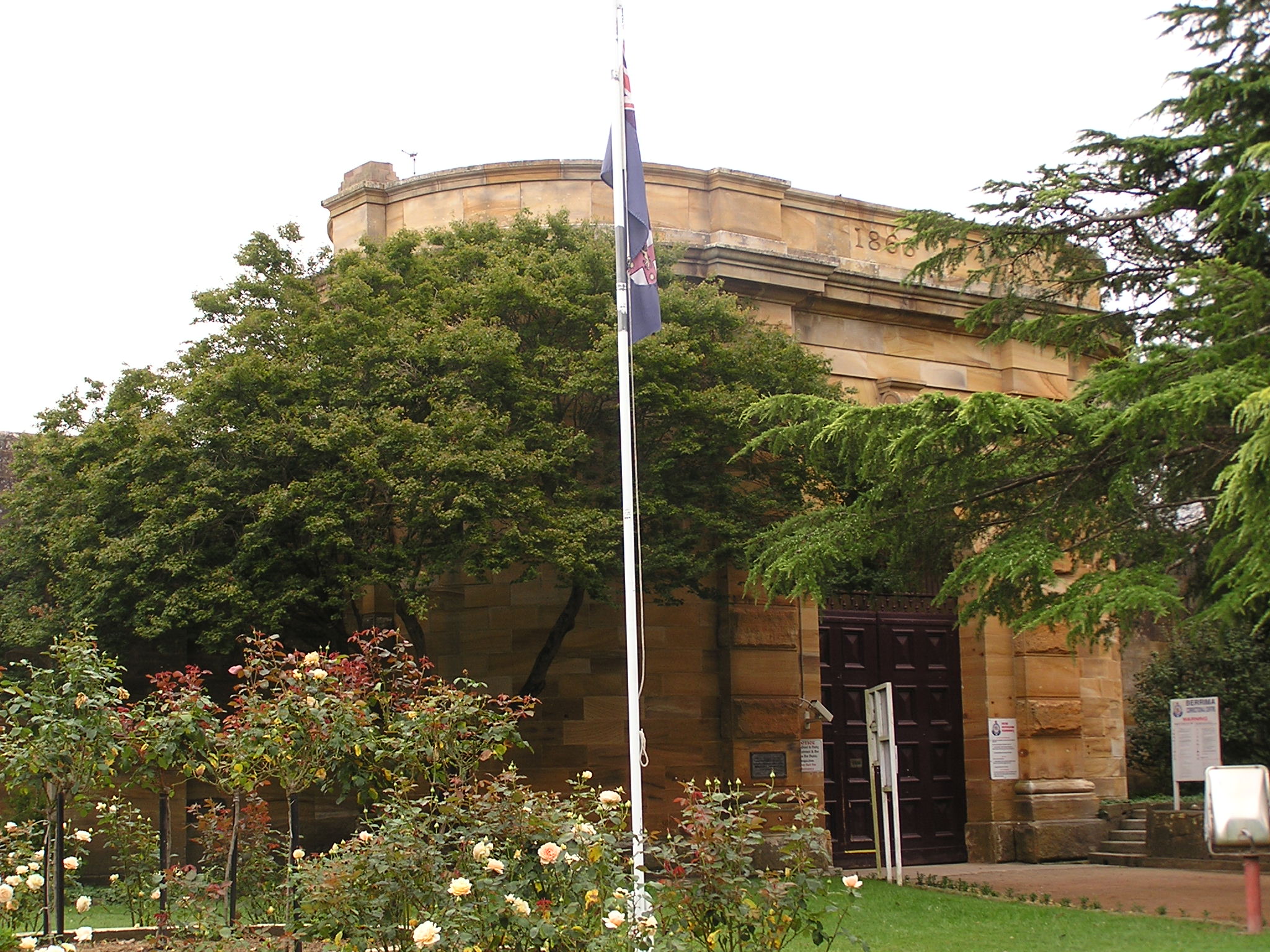The historic town of Berrima is situated in the Southern Highlands of New South Wales, Australia.
Berrima, which was established in the 1830s,
is Australia's oldest Georgian village.
The Gundangara People
The name of the town of Berrima means "southward" or "black swan" in the Gundangara, Aboriginal language.
The
Gundangara people, whose traditional land includes the area around Berrima, lived a hunter and gather lifestyle before the
arrival of the British.
The Gundangara people believed
that the landscape was created by the struggle between two creator beings, the Gurangatch, a type of "rainbow serpent", and Mirragan, a "quoll-man".
Various cultural rituals and protocols practised by Aboriginal people are also part of modern Australia. These include, "Welcome to Country", where Traditional Custodians give their blessing for an event and "Smoking Ceremonies", a purification ritual performed by a knowledgeable Aboriginal person.
 |
| Aboriginal Bora Ceremony - circa 1900 |
 |
| Australian Aboriginal rock painting of the "Rainbow Serpent". |
The Europeans and Escape To China
Berrima first came to the attention of the British in 1798, when Governor John Hunter sent a party to the region, led by ex-convict John Wilson, to investigate the area and to provide information to counter the wild stories circulating amongst the convicts that, China and a means of escape, lay somewhere to the south
of the region.
The expedition returned to the Governor, with positive descriptions about the land that would become the Southern Highlands. However, the resources were not available to develop the region until 1818, when Hamilton Hume, James Meehan and Robert Hoddle were sent to conduct a survey of the area, for Governor Lachlan Macquarie.
Major Thomas Mitchell selected Berrima for development in 1829, as a new road from Sydney was required to replace the old, very steep Argyle Road, over the Mittagong Range. Mail coaches were soon passing through Berrima, on the new road, and the town began to develop.
Berrima Gaol often called "bury-me gaol", was
built from the local sandstone between 1836 and 1839, by convicts in chains. A bishop who was visiting the region described one of the chain gangs as "...fettered with heavy chains, harassed with heavy work, and fed on salt meat and coarse bread, their faces are awful to behold and their existence one of desperation".
 |
| Convict labourers, creation: 1826 |
 |
| Berrima Gaol, Daily Telegraph (Sydney, NSW : 1883 - 1930), Wednesday 12 July 1922 |
Administrative Centre
The plan for Berrima to be established as a commercial and administrative centre for the County of Camden was flourishing by 1840. The gaol was built from 1835-9 and the Court House in 1838. Blocks of land, however,
were first sold in 1833. Bryan McMahon was granted title to land at the corner of Bryan and Jellore Streets, where he would establish the Berrima Inn, also known as McMahon's Inn (The (Coach & Horses Inn). The inn was in operation until 1848, after which, Brian McMahon and his family resided there until his death.
 |
| Berrima Court House, built 1838, Sydney Morning Herald (NSW : 1842 - 1954), Saturday 7 July 1934 |
Other inns which operated in Berrima's early days, were the Surveyor-General Inn, the Mail Coach Inn, and the Crown Inn. Holy Trinity Anglican Church
was designed by Edmund Blacket. And built from 1849 and St Francis Xavier's Roman Catholic Church was built from 1849 to 1851, by William Munro.
An English-Style Village
By 1841, 37 houses had been built at Berrima and 7 more were being constructed. The population was 249. Berrima at this time was developing into a
substantial town and administrative centre, with its impressive early Greek-revival style courthouse and other solid, Georgian buildings. From 1841, the Supreme Court Circuit had a Police Magistrate, Clerk of Petty Sessions, and nine police constables.
Many people j
ourneyed to Berrima from Sydney in the early days and at one stage, the town had 13 inns, which were described by Reverend John Dunmore Lang, as being operated by publicans of a "low character".
By 1851, the population of Berrima had dropped to 192, as Berrima began to
lose its importance after the Circuit Court was moved to Goulburn in 1850. Although, Quarter Sessions continued at Berrima, conducted by local magistrates. Berrima Court House continued to function as a district court until around 1900.
 |
| Surveyor General Hotel, Berrima, N.S.W. - early 1900s |
 |
| Surveyor General Inn, Berrima, N.S.W. Built 1834 |
Berrima Serial KIller
John Lynch, born in 1813 in Cavan, Ireland, was transported to Australia on the ship Dunvegan Castle, 1 July 1832, at the age of 19, after being convicted of false pretences. Lynch was billeted out to Berrima, where he worked on various farms as a convict labourer. Then, Lynch joined a gang of bushrangers.
In 1835, Lynch and two other members of his gang were charged with killing Tom Smythe, who had given evidence against Lynch's gang. Lynch admitted to the crime, but while the other two men were hung, the jury did not believe Lynch, and he was set free.
 |
| Picton Post (NSW : 1907 - 1954), Wednesday 1 March 1933 |
After this, Lynch embarked on a murder spree, and it is believed that he killed about ten people in the Berrima area. The law
finally caught up with Lynch, and he was executed by hanging in Berrima Gaol, on 22 April 1842.
Bushranger Jackey Jackey
William Westwood, also known as Jackey Jackey, was an English-born convict who also became a bushranger. It was in 1840 after he received 50 lashes for trying to escape, that Westwood took to bushranging. He was captured at Berrima in the following year, at the Black Horse Inn. However, life only went downwards for him after this, as he was sent to Cockatoo Island and then, was transported for life in 1842, to Port Arthur, Van Diemen's Land, for trying to escape again. In the end, Westwood
was executed at Norfolk Island, as the leader of the 1846 Cooking Pot Uprising.
 |
| Death mask of bushranger William Westwood, also known as Jackey Jackey, State Library of New South Wales |
James Harper
Harper's Mansion was built by James Harper, who was born in 1805 to parents who were both transported convicts. James, the couple's only son, was baptised by the Rev. Samuel Marsden, in Parramatta, on 22 December 1805. James' wife, Mary Robinson, a convict, was initially given a death sentence, but
she was transported instead, to the colonies, for 14 years, for the crime of robbery.
In 1834 James purchased 100 acres of Crown Land at Berrima and he probably built his house not long afterwards. James also built The Surveyor General Inn, named after Thomas Mitchell.
 |
| The Surveyor General Inn, Berrima, built in 1834 for James Harper, using convict labour Daily Telegraph (Sydney, NSW : 1883 - 1930), Saturday 15 December 1923 |
Joseph Levy of the Victoria Inn
The Victoria Inn was built by Joseph Levy, an ex-convict who became a businessman. The inn was first licensed in 1840, operating as an inn and brewery. Philip Solomon was the initial licensee.
 |
| Levy's Hotel and Berrima Coach to Sydney, Australian Town and Country Journal (Sydney, NSW : 1870 - 1907), Saturday 19 March 1898 |
James Powell
James Powell was conducting business in Berrima by 1850. He
was an ex-convict, who married Mary Riches in 1843. But Mary died in 1852, leaving James with five children. In the following year, James married Jane Henshall, at Holy Trinity Anglican Church, Berrima and the couple began to have their own children.
James operated various businesses in Berrima and he was also elected to Warden of Holy Trinity Church in 1858. When he died in 1885, James owned land and three buildings in Berrima: the School of Arts building, Bellevue House and The Queen Victoria Inn (Allingham House).
 |
The Queen Victoria Inn built by Joseph Levy and later owned by James Powell,
Canberra Times (ACT : 1926 - 1995), Saturday 28 August 1965 |
A View Of Berrima
 |
| View from Church Hill, Berrima, NSW, in 1900 |
Football
 |
| Berrima-Camden Football Team, Sydney Mail and New South Wales Advertiser (NSW : 1871 - 1912), Saturday 27 July 1901 |
Public School
The original sandstone Berrima Public School building opened in 1870, with about 50 students. However, there were earlier schools in the town. The people of Berrima raised one-third of the cost of the building.
 |
| Berrima Public School, opened 1869, photo 1913. State Records NSW |
WWII "Enemy Aliens"
The gaol was closed in 1909, but during WWI, Berrima Gaol became an internment camp for hundreds of German and Austrian men; mostly German ship's officers and sailors who were in Australia at the outbreak of the war. The men named the gaol Ahnenschloss (Castle Foreboding). These men who were regarded as being "enemy aliens",
created gardens and a recreation area next to the Wingecarribee River and these gardens, strangely enough, would inspire tourists to once again, visit the Berrima area.
 |
| A group of German prisoners of war playing zithers and guitars in their national dress, Berrima Concentration Camp, New South Wales, ca. 1916. National Library of Australia |
 |
| German Internment Camp, Berrima |
Post War
After the war, In 1948, the Berrima Training Centre, a minimum security correctional centre opened at the Berrima Gaol.
 |
| Sign painting Berrima Prison, NSW, Sunday Herald (Sydney, NSW : 1949 - 1953), Sunday 2 August 1953 |
Industry
The Berrima cement works began operation in the latter half of 1927 with cement production commencing in May 1929. The town of New Berrima was established in 1928, to house the cement works and mine employees and their families.
 |
| Locomotives 5464 and 5428 at Berrima Cement Works, NSW, circa 1964, Aust.Rail.Hist.Soc Railway Resource Centre |
Around Berrima
Today, Berrima is one of the few remaining intact villages of the colonial period, with irreplaceable cultural and architectural history, set in beautiful natural surroundings.
 |
| Berrima House was built in 1835, Burma NSW. bushranger Ben Hall, the bushranger is said to have slept here in 1864 |
 |
| Colonial Inn Berrima, built by 1834, in Colonial Georgian cottage style, Originally Breen’s Inn, Berrima, NSW |
 |
| Berrima Post Office is a heritage-listed post office at Argyle Street, Berrima, NSW, was built in 1886 by R. N. Matthews |
 |
| CBC Bank Building, built about 1836, is a heritage-listed bank building at 12 Jellore Street, Berrima, The land consisting of numbers 10, 12 and 14 Jellore Street was purchased by John Keighran of Campelltown in 1834 and 1835 |
 |
| The "Settler's Hut" at the rear of Jellore cottage was erected in Wheeo as a bushman's hut c. 1840s, and after falling into disrepair, was moved to Berrima, NSW, and re-erected in the 1990s. |
 |
| Magistrate's House, built 1860s. by James Higgins, an early Berrima storekeeper. The house was later leased to the police magistrate from 1873 to 1891, NSW |
 |
| Masonic Hall, Berrima, NSW, 1867. Built by James Powell. It later served as the School of Arts and in 1929, it became a Presbyterian Church. Now a residence. denisbin |
 |
| The Former Queen Victoria Inn in Jellore Street Berrima, NSW, built circa 1840, later known as Allington House, was the the home of James Powell. |
 |
| HolyTrinity Berrima Anglican Church. Berrima, NSW |
.jpg) |
| A shop in Berrima, NSW |
 |
| Strolling in Berrima, NSW |
 |
| Historic Court House in Berrima (completed 1838), NSW |
 |
| St Francis Xavier's Church. Opened 1851, Berrima, NSW |
 |
| White Horse Inn, built from sandstone circa 1832, Berrima, NSW |
 |
| Part of Berrima Gaol, built 1830s, NSW |
 |
| Harper's Mansion Berrima, about 1834, Berrima, NSW |
 |
| Breen's Commercial Inn, circa 1840. Now a restaurant, Berrima, NSW |
 |
| Governor's residence, Berrima. Built in 1898, NSW |
 |
| Bell Gallery, Berrima, NSW | | |
|
 |
| A house in Berrima, NSW |
 |
| Historic stone cottage in Berrima, The old Berrima Bakery, NSW, circa 1850 |
|
|
Historic Berrima farm, NSW, Mereworth, was owned by the Oxley family, who are decedents of the Bushells Tea founders
|
.jpg) |
| Taylor’s Crown Hotel, circa 1840s, Berrima, NSW |
 |
| Former Royal Mail Coach Inn, operated from 1839 to 1850 , Jellore Street, Berrima, NSW |
 |
| Sandstone façade of the old Berrima gaol, constructed between 1863 and 1868 |
Things To Do and Places To Go
Historic Berrima Walking Guide



























.jpg)









.jpg)





